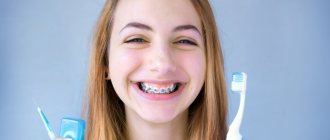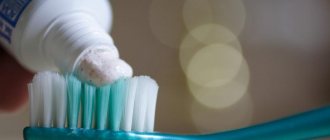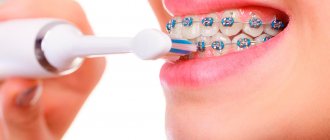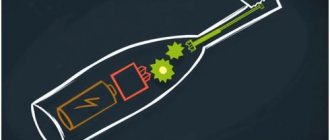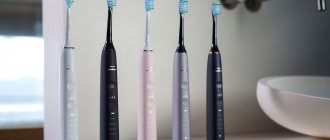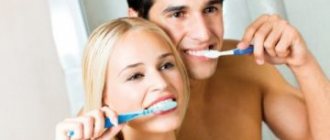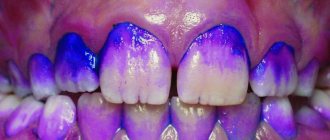Wearing braces does not replace the need to take care of your teeth. During the period of correcting the bite, the issue of hygiene arises especially acutely, because neglecting this point can lead to the development of caries. Treating teeth while wearing braces is inconvenient and undesirable, so it is better to prevent the problem than to solve it. Following simple care recommendations can significantly reduce the risk of inflammation or diseased teeth.
It is important to understand that the orthodontic structure itself in the mouth already increases the risk of plaque and tartar formation on the teeth and can cause inflammation in the oral cavity and gums. This does not mean that you need to abandon bite treatment, but it is necessary to increase attention to care issues.
A special brush is a must have for braces wearers
Orthodontic structures require increased attention from their owners. It is necessary to carefully monitor your diet so as not to damage the archwires, ligatures or break off the clasps. It is especially important to properly and fully carry out hygiene, which, as you might guess, is very difficult for wearers of braces. Can I clean my braces with a regular brush? If you do not brush your teeth properly, especially at the place where the locks are attached, at the gums and in the spaces between teeth, demineralization of the enamel, multiple caries, and gum inflammation may occur. Therefore, oral hygiene products must be special: not only able to fit into all possible gaps in the structure, but also without the risk of damaging it.
Types of orthodontic brushes
Due to the special structure of braces, it is not possible to use ordinary oral hygiene items to clean them. The use of ordinary brushes does not help to effectively clean the oral cavity, because the bristles simply do not reach many places. But scientists have developed many different specialized brushes for cleaning braces , which take into account all the features of this bite correction system.
There is an opinion that while wearing braces, you can use a regular brush, the main thing is to take a product with soft bristles. Dentists think differently: studies have shown that ignoring specialized products doubles the likelihood of developing caries!
V-shaped
The V-shaped brush is very similar to a regular brush. The only difference is that in the central part in the longitudinal direction the product has a reduced bristle length. It is believed that this form allows you to simultaneously clean the enamel, on which there are no braces, and the braces themselves. Among these brushes there are standard ones (with bristles) and non-standard ones (with rubber pads or rubber bristles). Whether it is worth using newfangled solutions should be checked with a doctor.
Standard V-shaped brushes
Monobeam
A mono-tuft toothbrush for cleaning braces has only one tuft of bristles on a plastic handle. It is very thin, so it easily cleans surfaces that are inaccessible to ordinary brushes. This product is used after a regular brush and brush: it is designed to remove all those small food debris that other cleaning devices cannot reach.
Some people think that using a single-tuft brush is not necessary, but this is not true. It helps remove dirt around the locks, which is very important. If you do not clean this area, you will see discoloration of the enamel after your braces are removed.
An example of a monotuft brush and its application
Electrical
Electric brushes can be used with braces , but be very careful. If you bought a model in which the head makes rotational movements, you cannot use it - the bristles may get stuck in the metal structures. Dentists do not recommend using a working head in the area of braces; it is dangerous and can lead to breakage of the locks. In addition, electric models are designed for routine care, so they are not enough for full care.
You can combine specialized tools such as brushes and mono-tuft brushes and an electric model. In this case, the surfaces of the teeth that are not covered by braces are automatically cleaned, and the rest of the enamel is cleaned manually.
Advice! If your budget allows, in addition to a special brush, also buy an irrigator. It does not replace brushing your teeth, but helps remove plaque and food debris with water. You can also rinse your teeth with medications, this reduces the risk of inflammation and gum disease.
Cleaners
Brushes for braces are used to clean the spaces between the arch and teeth. They consist of a holder and replaceable heads, each of which lasts no more than 2 weeks. The holder can be of any shape and often resembles a brush handle. The head itself looks like a small wire base on which there are bristles sticking out in all directions.
Types of dental brushes and an example of their use
Cleaners are classified according to the following parameters:
- the shape of the working part. Models come in conical and cylindrical. Conical ones taper towards the end, cylindrical ones have a constant nozzle width;
- the stiffness of the bristles, which can be hard or soft. The latter is used for sore gums or increased sensitivity;
- size. It is recommended to use brushes of different sizes for different teeth, because... the distance between the elements of the dentition can vary over a fairly wide range.
Regardless of their hardness, brushes do not last long. It is recommended to take them in sets so as not to run to the store for your next purchase as soon as the bristles of the brush you are using wear out.
Sizes of brushes and features of interdental cleaning
Sets
To care for your teeth during the period of bite adjustment, you need a lot of equipment. You don’t have to buy them separately: you can immediately buy a set, which will include a toothbrush with braces , a brush, and a mirror. The main thing is that such a set includes all the products necessary for care.
Two examples of dental care kits
The minimum configuration is as follows:
- v-shaped brush;
- toothpaste;
- waxed floss for dental purposes;
- floss toothpicks or dental brushes;
- mono-beam brush;
- mirror.
Even such a small specialized kit will help you take full care of your teeth. An additional advantage of buying a set is that it is usually sold in special packaging that is convenient to carry with you. The kit is also suitable for travelers. But do not forget that brushes quickly become unusable and need to be replaced.
Advice! If you find the kit inconvenient for constant use, you can purchase two sets of accessories. You will carry one with you when eating at a restaurant or dining out, and use the other at home.
V-shaped brush for braces
Cleaning braces involves two multidirectional tasks: on the one hand, it is necessary to thoroughly clean out plaque and food particles, on the other hand, this must be done as carefully as possible so as not to damage the structure. Brushes with soft bristles and a special recess for locks - V-shaped - can handle this. They can clean the area around the bracket and the bracket itself at the same time. They tend to be more resilient when wet because they are made from polyester, which can absorb moisture better than the nylon used in regular brushes. And the soft bristles prevent damage to the gums and are suitable for increased tooth sensitivity.
Nutritional Features
Installing braces implies not only compliance with the rules of caring for them, but also certain restrictions in the process of eating. So, in order not to create unnecessary problems for yourself, it is recommended to refuse:
- solid foods that can negatively affect your bite;
- sticky and viscous foods that can negatively affect the enamel;
- products with dyes, as they will change the color of the structure and make it unsightly;
- excessively cold or hot food, which can affect the physical properties of the system and reduce its efficiency.
It is important to know: A mandatory requirement is to refuse, unconditionally and completely, from chewing gum. This harsh approach is justified by the fact that the sugar it contains causes caries, plus, chewing gum can lead to braces coming off, which will lead to an increase in the number of visits to the doctor and delay of treatment.
Can I clean my braces with an electric brush?
Electric toothbrushes can be used in patients with braces. In this case, you need to choose special attachments: narrower and with soft bristles. It is desirable that it operates in reciprocating rotation mode. It should be taken into account that the bristles of an electric toothbrush wear out much faster in orthodontic patients. Approximately every two to four weeks you will have to change the attachments. However, it does not relieve the “brace-bearer” from using other hygiene products, such as brushes or mono-tuft brushes, which allow you to clean the narrowest and hard-to-reach places.
Adaptation period
Getting used to the system and the devices used to care for it will take some time. While adaptation continues, the patient will have to experience some discomfort when eating, and he will also have certain problems with diction, but there is no need to be afraid and despair, such troubles will be overcome quite quickly.
On average, an adult will need no more than 10 days to get used to it; a teenager or young man will need even less, a maximum of a week. Painful sensations may not necessarily occur only in the teeth that experience pressure from the plates; often the gums also experience discomfort. If adaptation is very difficult, then the dentist may, at the patient’s request, slightly weaken the system so that the painful sensations are not too strong; in addition, it may be necessary to take painkillers.
A special place is occupied by special means that are used to care for oral hygiene. Their use extends throughout the entire period of wearing braces; moreover, care during this period should be especially thorough.
Toothbrush for braces
Cleaning the space between the bracket and the arch, interdental spaces and hard-to-reach places is not an easy task. That is why, after installing braces, doctors recommend that their patients use y or toothbrushes. They easily remove plaque in hard-to-reach areas and between teeth. Their bristles are longer than regular brushes, and their heads are much smaller, which allows them to penetrate deep under the orthodontic structure and effectively cope with plaque in the area of wisdom teeth and crowded teeth.
Additional activities after cleaning
In addition to directly brushing teeth during orthodontic treatment, some other manipulations may be required to improve the patient’s quality of life - this is rinsing the mouth and working with wax.
Mouthwash
Dentists recommend using mouthwash daily. This allows you to quickly freshen your breath, while chewing gum remains an unaffordable luxury for patients with braces.
In addition, regular rinsing of the mouth with antiseptic solutions helps relieve inflammation, which especially often makes itself felt in the first days of wearing braces.
Why do you need wax?
If you buy a set for cleaning braces, then in the vast majority of cases it will also contain wax in addition to the already familiar listed tools. Why is it needed?
It is no secret that the sharp edges of braces and even the arch can cause microtrauma to the mucous membrane of the tongue, lips and cheeks. This is especially noticeable in the first 2-3 weeks of wearing braces, when all the known shortcomings of this orthodontic system are maximally manifested.
To avoid the formation of wounds, bleeding and generally improve the patient’s quality of life and increase his loyalty to treatment, orthodontists recommend the active use of wax. A small amount of it must be kneaded in your hands and applied to the part of the bracket with sharp edges. Gradually, this will no longer be necessary, as the oral mucosa adapts to the structure on the teeth.
Ultrasonic brush for cleaning teeth with braces
Ultrasonic brushes can greatly simplify oral hygiene for orthodontic patients. A brush operating on pure ultrasound does not even require sweeping movements on the surface of the teeth, which means that its head does not wear out due to constant friction against the clasps and arches of braces, and there is no risk of damaging the structure. Ultrasound effectively removes plaque and even tartar, penetrates deeply into the gums, and fights microbes in periodontal pockets. Using a special toothpaste that can create microbubbles allows you to clean your mouth even more efficiently.
What happens if you don't use it?
If you do not use special brushes for cleaning, then in the future there may be such negative consequences as:
- Formation of tartar (due to the accumulation of plaque in hard-to-clean places).
- Darkening and thinning of tooth enamel.
- The emergence and development of caries.
- Darkening of the metal arches of the bracket system itself.
To avoid various risks, it is recommended to use such brushes regularly. Otherwise, the method does not guarantee 100% results.
How to brush your teeth with a braces brush?
First, you should walk along both rows of teeth with horizontal movements, and then with comma-like movements, positioning the brush so that the notch is located in the area of the locks. Be sure to grab the gum area. Then turn the toothbrush so that its long bristles can clean the bottom edge of the braces clasps, and do the same on top. Clean the chewing surface of your teeth with forward movements, and the inside with sweeping movements. Next, use dental floss or special brushes to clean the interdental spaces, the space above and below the arch. At the end of the cleaning, you can use it, adjusted in accordance with the recommendations of your orthodontist. While wearing braces, you need to brush your teeth after every meal, at least three times a day. During the day, you can limit yourself to a brush, paste and brushes; in the evening, when you have more time for hygiene, use a floss and irrigator.
How to choose the right one?
When choosing a suitable device, you must consider the following important nuances :
- Length of bristles - if the teeth fit tightly together, then it is better to choose a product with short bristles. If there are small gaps between the teeth, then a product with long bristles would be an ideal option.
- Brush length - small sizes are suitable for children, larger sizes for adults (L, XL).
- Bristle hardness - dentists advise choosing products with medium bristle hardness. But people with sensitive or damaged enamel should give preference to soft brushes.
- The length of the handle of the product should be based on personal considerations of comfort during cleaning. Some people find it convenient to hold a product with a short handle, others with a long handle.
- Product quality - it is advisable to choose products from well-known brands, after studying consumer reviews.
According to dentists, the most convenient to use are cone-shaped brushes.
They not only effectively clean braces, but also interdental spaces, eliminating plaque and bacteria accumulation.
Where can I buy a brush for braces?
Today it's pretty simple. Prices for brushes for braces vary depending on the company. Orthobrushes cost from 200 rubles, single-beam ones - from 260 rubles, orthodontic attachments for electric brushes will cost from 300 rubles and more.
In addition to the usual care with toothpaste, brushes, floss and brushes, dentists recommend using irrigators. They are able to remove food particles even from the most difficult to reach places without damaging the orthodontic structure. Modern devices are equipped with several operating modes, allowing you to use both mono jet and bubble cleaning for more effective hygiene.
Tools for caring for braces
Devices for caring for the oral cavity during orthodontic treatment may seem strange and uncomfortable at first glance, but they are not. If you are interested in where in Moscow you can buy an orthodontic toothbrush and brushes for cleaning braces, then just ask your dentist or search on the Internet. Today, most pharmacies and a large number of online stores offer a full range of hygiene products for patients undergoing orthodontic treatment. Moreover, the prices for these tools can vary, both from quite high for products of professional dental brands (for example, toothbrushes and brushes for Curaprox braces), and to absolutely affordable brushes from mass market brands (toothbrushes and brushes for Oral braces B (oral bi).
Recommendations
The effectiveness of cleansing will largely depend on the correct implementation of the following recommendations:
- It is better to give preference to synthetic bristles rather than natural ones, since the latter has many pores where harmful bacteria accumulate, causing inflammation;
- the diameter of the brush head should not exceed 250 millimeters for adults and 200 for children;
- soft bristles are better than hard bristles in terms of penetration;
- It’s good to also use an irrigator after cleaning, which can wash away food debris from those places where the brush could not fully reach.
Colgate Ortho (USA)
According to the manufacturer, the Colgate Ortho braces toothbrush was developed with the help of dentists, and therefore meets all the requirements for this type of product. The head contains soft and hard bristles. The soft ones are located on the outer edge and help to gently remove plaque from the gums and the enamel adjacent to the braces. The hard ones are located inside, and therefore do not damage hard tissues and do a good job of cleaning the surfaces of the orthodontic apparatus. Cost – from 160 rubles.
Colgate Ortho
Vitis Orthodontic (Spain)
The manufacturer of this brand offers the following toothbrushes for braces with a V-shaped bristle profile:
- Orthodontic: hardness – medium, head length – standard, 2.7 mm,
- Orthodontic Access: hardness – medium, head length – reduced, 2.0 mm.
When purchasing, you can choose any of the following colors: transparent, green, red, yellow, purple, blue. Cost - about 300 rubles.
The VITIS company offers owners of braces systems different sets of oral care products, which, in addition to a brush with a V-shaped cutout, also include other devices: specialized toothpaste from the Orthodontic series, mouthwash, brushes and wax.
Vitis Orthodontic
Curaprox Ortho CS5460 (Switzerland)
This orthodontic brush is not a cheap option. Cost – from 7302 rubles (this price tag is indicated on the manufacturer’s website, beginning of September 2022). However, according to experienced doctors, as well as patients who have tested Curaprox Ortho CS5460 in action, it is worth the money.
The head of this brush for braces contains 5460 special patented CUREN bristles, which create a very voluminous and dense surface. At the same time, they practically do not absorb moisture and have a high cleaning ability. Plaque is effectively removed, including in the area of the periodontal sulcus, which in the long term reduces the risk of developing inflammatory periodontal diseases.
The head of the device is small and maneuverable, tilted. The handle is octagonal. Buyers can choose the Curaprox Ortho braces brush in different colors: green, orange, blue, purple, pink.
“I had curaprosks. Very soft, comfortable, the bristles do not spread or get stuck in the locks. Cleans well in difficult places and removes food residues. True, it fluffed up very quickly, after only 3 weeks of use. I expected that for such a price it would last longer!” T.A., review from the dental portal gidpozubam.ru
Curaprox Ortho CS5460
Description of the capabilities of brushes
The bracket system has a lot of small elements. During a meal, food particles often get stuck between structural parts. Traditional accessories for cleaning teeth will not be enough if a person wears braces. Contamination should be removed immediately. Special orthodontic brushes (brushes) do an excellent job of this. The modern market for hygiene products offers a huge variety of such tools. They make cleaning teeth and braces of all types much easier.
Brushes for braces can be purchased at a pharmacy, supermarket or dental store. The price varies between 300-500 rubles, and depends on the manufacturer’s brand. Products from brands such as Rox, Colgate, and Oral B are popular. An orthodontist will help you avoid mistakes when choosing an accessory. He, taking into account the personal characteristics of the patient and the installed braces, will recommend the most suitable type of brush for cleaning the device.
Brushes designed for caring for braces come with different tips:
- with forked;
- with extended ones;
- with shortened ones.
To achieve impeccable oral cleanliness, you need to know how such products should be used. The skill of correct use is developed after just a few procedures.
Brushes for braces
It is worth noting that if you neglect the use of special brushes for cleaning braces, then soon after installing the corrective system you may encounter many troubles, namely: the formation of plaque, caries on the teeth, as well as inflammation of the gums, changes in the original shade of the braces (especially vulnerable in in this regard, plastic and ceramic products). Pigmentation causes the device to become visually unattractive.
Lifetime
Answering the question about the duration of wearing the structure is not as simple as it might seem. This aspect is influenced by the following factors:
- the age of the patient - the younger he is, the less time is needed;
- degree of complexity of the problem - the simplest situations will require wearing the system for no more than a year, the most complex ones will require much more time;
- the health status of the patient's teeth - if there has been no prosthetics or depulpation before, then the wearing time will be shorter.
Three years, if we talk about the most problematic cases, of course, is a considerable period of time; to many, even one year seems an unreasonably long time, but it is still not worth using devices for acceleration. They are very expensive, but are not able to change human bone tissue, so their purchase is not justified. You also need to remember that ignoring proper and high-quality oral hygiene will lead to a delay in treatment and a decrease in its effectiveness.
Why do my teeth hurt after installing and activating braces?
In the first days after installation, and subsequently after activation of braces, aching sensations of varying degrees of intensity are possible - the stronger the defect, the greater the pain. When fixing ligature systems, the pressure is greater, so the teeth will hurt more. Soreness in general is a completely normal reaction, since braces from the first minutes after fixation already have an impact on the teeth and change their position.
If the pain is severe, then in the first days after installation or activation of the system, you can take painkillers. But no more than 2-3 days. If discomfort persists, contact your orthodontist for system correction.
Popular models of brushes
Travel kit Pierrot Orthodontic Kit
Manufacturers of orthodontic products offer a wide range of special brushes and brushes. There is a certain demand for models such as:
- Vitis . It has a V-shape, miniature head, rounded bristles. Does not injure the mucous lining of the mouth.
- Pierrot . Features a compact head. The bristles are V-shaped.
- Сuraprox . It features a rounded tip, which allows you to thoroughly clean the enamel from various deposits. The bristles are made of elastic polyester.
- Miradent . The set includes two pairs of tips. The bristles are cone-shaped. The handle is ergonomic. A case for storing attachments is provided.
- Vitis Implant Monotip . The fibers are collected in a bundle. The product delicately but effectively cleans the enamel in the areas where the orthodontic device is attached.
- Antiplaque Piave Dental Care . V-shaped bristles, medium level of hardness. Helps remove plaque from hard-to-reach areas.
- EDEL+WHIT . The set includes two accessories. When using them, you don't have to apply toothpaste. The devices perfectly clean those areas of the dentition that classic brushes do not have access to.
